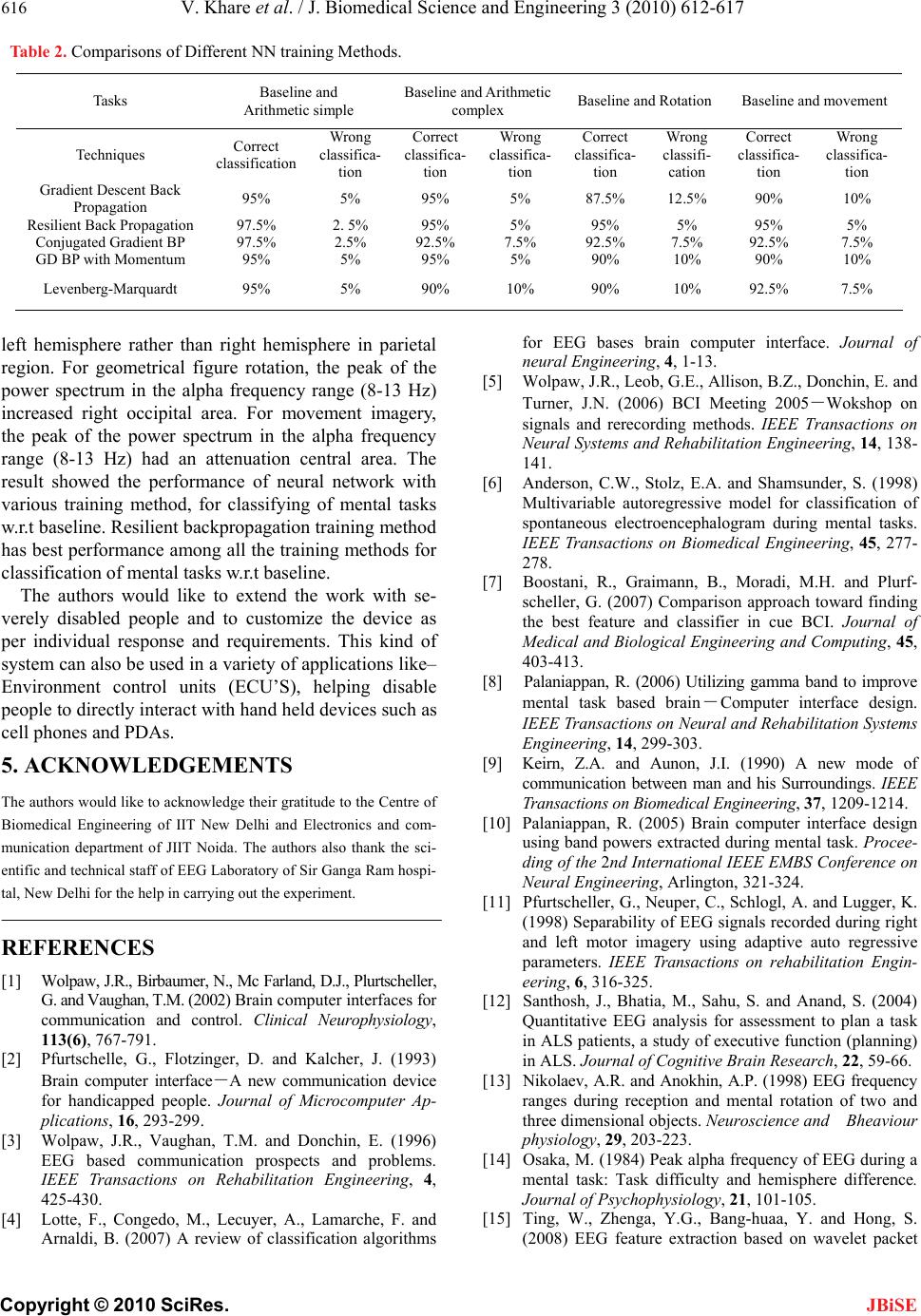
616 V. Khare et al. / J. Biomedical Science and Engineering 3 (2010) 612-617
Copyright © 2010 SciRes.
Table 2. Comparisons of Different NN training Methods.
Tasks Baseline and
Arithmetic simple
Baseline and Arithmetic
complex Baseline and Rotation Baseline and movement
Techniques Correct
classification
Wrong
classifica-
tion
Correct
classifica-
tion
Wrong
classifica-
tion
Correct
classifica-
tion
Wrong
classifi-
cation
Correct
classifica-
tion
Wrong
classifica-
tion
Gradient Descent Back
Propagation 95% 5% 95% 5% 87.5% 12.5% 90% 10%
Resilient Back Propagation 97.5% 2. 5% 95% 5% 95% 5% 95% 5%
Conjugated Gradient BP 97.5% 2.5% 92.5% 7.5% 92.5% 7.5% 92.5% 7.5%
GD BP with Momentum 95% 5% 95% 5% 90% 10% 90% 10%
Levenberg-Marquardt 95% 5% 90% 10% 90% 10% 92.5% 7.5%
left hemisphere rather than right hemisphere in parietal
region. For geometrical figure rotation, the peak of the
power spectrum in the alpha frequency range (8-13 Hz)
increased right occipital area. For movement imagery,
the peak of the power spectrum in the alpha frequency
range (8-13 Hz) had an attenuation central area. The
result showed the performance of neural network with
various training method, for classifying of mental tasks
w.r.t baseline. Resilient backpropagation training method
has best performance among all the training methods for
classification of mental tasks w.r.t baseline.
JBiSE
The authors would like to extend the work with se-
verely disabled people and to customize the device as
per individual response and requirements. This kind of
system can also be used in a variety of applications like–
Environment control units (ECU’S), helping disable
people to directly interact with hand held devices such as
cell phones and PDAs.
5. ACKNOWLEDGEMENTS
The authors would like to acknowledge their gratitude to the Centre of
Biomedical Engineering of IIT New Delhi and Electronics and com-
munication department of JIIT Noida. The authors also thank the sci-
entific and technical staff of EEG Laboratory of Sir Ganga Ram hospi-
tal, New Delhi for the help in carrying out the experiment.
REFERENCES
[1] Wolpaw, J.R., Birbaumer, N., Mc Farland, D.J., Plurtscheller,
G. and Vaughan, T.M. (2002) Brain computer interfaces for
communication and control. Clinical Neurophysiology,
113(6), 767-791.
[2] Pfurtschelle, G., Flotzinger, D. and Kalcher, J. (1993)
Brain computer interface-A new communication device
for handicapped people. Journal of Microcomputer Ap-
plications, 16, 293-299.
[3] Wolpaw, J.R., Vaughan, T.M. and Donchin, E. (1996)
EEG based communication prospects and problems.
IEEE Transactions on Rehabilitation Engineering, 4,
425-430.
[4] Lotte, F., Congedo, M., Lecuyer, A., Lamarche, F. and
Arnaldi, B. (2007) A review of classification algorithms
for EEG bases brain computer interface. Journal of
neural Engineering, 4, 1-13.
[5] Wolpaw, J.R., Leob, G.E., Allison, B.Z., Donchin, E. and
Turner, J.N. (2006) BCI Meeting 2005-Wokshop on
signals and rerecording methods. IEEE Transactions on
Neural Systems and Rehabilitation Engineering, 14, 138-
141.
[6] Anderson, C.W., Stolz, E.A. and Shamsunder, S. (1998)
Multivariable autoregressive model for classification of
spontaneous electroencephalogram during mental tasks.
IEEE Transactions on Biomedical Engineering, 45, 277-
278.
[7] Boostani, R., Graimann, B., Moradi, M.H. and Plurf-
scheller, G. (2007) Comparison approach toward finding
the best feature and classifier in cue BCI. Journal of
Medical and Biological Engineering and Computing, 45,
403-413.
[8] Palaniappan, R. (2006) Utilizing gamma band to improve
mental task based brain-Computer interface design.
IEEE Transactions on Neural and Rehabilitation Systems
Engineering, 14, 299-303.
[9] Keirn, Z.A. and Aunon, J.I. (1990) A new mode of
communication between man and his Surroundings. IEEE
Transactions on Biomedical Engineering, 37, 1209-1214.
[10] Palaniappan, R. (2005) Brain computer interface design
using band powers extracted during mental task. Procee-
ding of the 2nd International IEEE EMBS Conference on
Neural Engineering, Arlington, 321-324.
[11] Pfurtscheller, G., Neuper, C., Schlogl, A. and Lugger, K.
(1998) Separability of EEG signals recorded during right
and left motor imagery using adaptive auto regressive
parameters. IEEE Transactions on rehabilitation Engin-
eering, 6, 316-325.
[12] Santhosh, J., Bhatia, M., Sahu, S. and Anand, S. (2004)
Quantitative EEG analysis for assessment to plan a task
in ALS patients, a study of executive function (planning)
in ALS. Journal of Cognitive Brain Research, 22, 59-66.
[13] Nikolaev, A.R. and Anokhin, A.P. (1998) EEG frequency
ranges during reception and mental rotation of two and
three dimensional objects. Neuroscience and Bheaviour
physiology, 29, 203-223.
[14] Osaka, M. (1984) Peak alpha frequency of EEG during a
mental task: Task difficulty and hemisphere difference.
Journal of Psychophysiology, 21, 101-105.
[15] Ting, W., Zhenga, Y.G., Bang-huaa, Y. and Hong, S.
(2008) EEG feature extraction based on wavelet packet